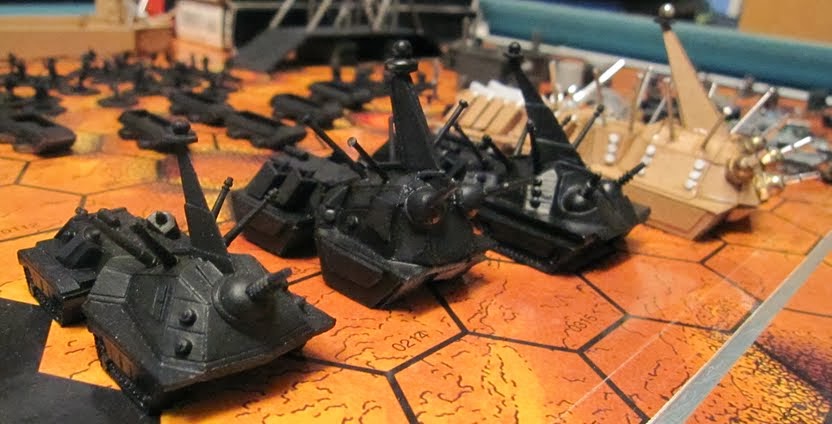It never made much sense to me that more long range nuclear weapons and aircraft weren't used in the ogre universe other than the obvious complexity it adds and the imbalance to game rules. The official explanation given for the lack of planes was essentially "lasers, that's why" saying that the lasers present were too accurate for planes. As for long range nuclear weapons the explanation given is that strategic nuclear weapons costs were too prohibitive and alternatively that electronic warfare stopped the missiles too well. As for cost, nuclear weapons now are not that expensive for wealthy countries with nuclear power plants to produce in large amounts and I see no reason why this would have changed especially since small nuclear devices are clearly mass produced for the weapons of conventional troops and Ogres in the Ogre Universe and making larger ones should not be more expensive than making several smaller ones. As for electronic warfare although I can see it accounting for some of the lack of long range nuclear weapon use missiles can be launched extremely long distances with minimal electronic guidance systems with our current calculating systems meaning that this cannot be the only explanation.
Here is some Ogre universe flavour that I wrote for the ogre universe to try to explain why more long range nuclear weapons are not used, along with some new unit stats.
Technology
Tactics and Logistics of Ground Combat in the late 21st century:
For much of the late 20th and early 21st
century no direct conflict waged between any two nuclear armed nations as this
would no doubt result in mutual destruction. From this many concluded that
large scale world war was a thing of the past.
To combat these problems laser technology, sensor
networks and enhanced automated tracking systems were developed, these new
systems could detect and disable or destroy most conventional warheads from a
significant range. These systems were immediately implemented in a stationary
and permanent manner around all sufficiently advanced countries assuring that
no long- range nuclear strikes could destroy them. This was done only under
scrutiny and mutual agreement by all nuclear capable countries through a series
of treaties and agreements. These “Laser Networks” were very reliable and used
a redundancy of lasers covering each other’s sector to help insure that if one
system failed it would not mean utter destruction. This network was linked
together and integrated with a variety of sensor equipment nearly flawlessly.
With strategic nuclear strikes thus limited the
problem became how to prevent long distance tactical strikes on advancing
armies and spearheads.
The solution was a mobile Laser network of “laser
brigades” stretched out behind the main advancing line of conventional troops.
These units were far too fragile and slow moving for conventional combat but
instead were placed with open line of sight as far toward the front as possible
without exposing themselves to combat. This mobile laser network would shoot
down any incoming high altitude missiles or planes long before they could
strike the advancing spearhead. Although this system proved far less effective
than the emplaced laser networks and was much more prone to failure, it
provided enough anti-missile and anti-aircraft defenses to mean that with
careful planning and logistical deployment conventional troops could advance at
a fairly high speed into enemy territory without being massacred.
This tactic along with the invention of BPC armor
brought with it the need for short range low altitude tactical nuclear devices
mounted on conventional units. Specialized cruise missiles were developed that
could sometimes, in barrages, make it through these mobile networks.
These missiles had thin layers of BPC, semi-intelligent
navigational systems, sensor jammers as well as their own anti-missile lasers.
Because of this they were high cost, but did not always work and were rarely
seen on the battlefield with any meaningful frequency.
Although all major and minor powers kept a
relatively small standing garrison of jet or VTOL fighters and bombers and even
some helicopters, they rarely saw combat against any but the least advanced
forces in the last war, standing by only to exploit a tactical opportunity or
to counter one.
This need for a defensive laser network meant that
assaults were limited to within the range of the mobile laser networks and made
for a very slow almost trench like warfare. This was characterized by quick
offensive thrusts into enemy territory followed by a slow reorganization as the
laser network moved forward to consolidate the gains.
There were some notable exceptions to these tactics.
Often forces invading small countries without a nuclear presence would move
ahead of their laser networks. Ogres would sometimes act outside this network
to make surprise raids on coastal areas and behind enemy lines, relying on
sensor jamming fields and disorganization to protect them. There were even
several cases of particularly daring commanders moving forward with only a
token number of laser units, enough to stop any test shots the enemy might fire
but not enough to stop a full out barrage of missiles. This tactic was
extremely uncommon and often ended in utter disaster but on occasion allowed
for much faster assaults than enemy troops had expected.
Rules:
Although these units essentially perform a strategic
role and would not be present on most Ogre battlefields at their scale here are
my imaginings for mobile and deployable laser units stats. These units could
appear on the battlefield for breakthrough scenarios, extended campaigns or
just for fun.
(Note these units have not been play tested)
Mobile
Laser Unit
Attack: 1
Range: 60"
Defense: 0
Move: 2"
Cost: N/A (By Scenario)
Re-deployable
laser unit
Attack: 2
Range 120"
Defense: 0
Move: 0
Cost: N/A (By Scenario)
-May be carried by hovertruck, assembles
or disassembles in 3 turns, alternatively may assemble or disassemble in 1 turn
if engineers are present.

.bmp)


.bmp)
.bmp)
.bmp)
.bmp)
.bmp)

.bmp)


